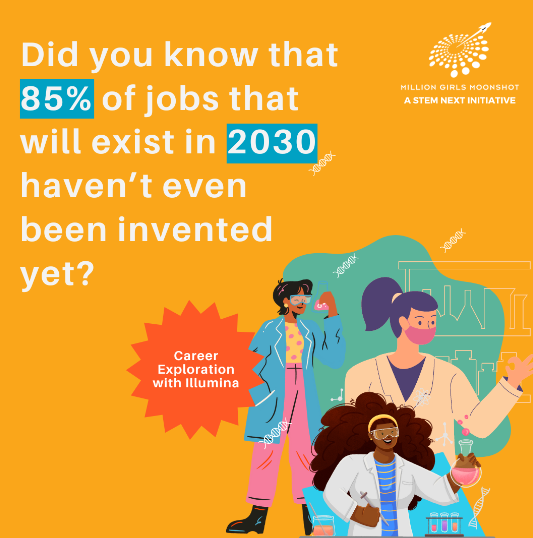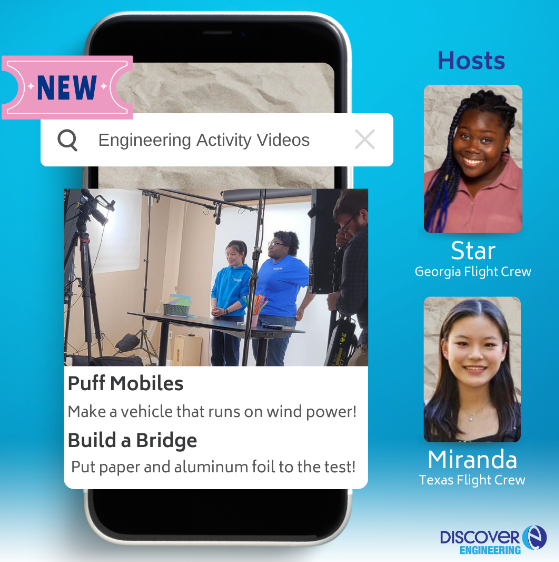
The Michigan Afterschool Partnership is proud to be a part of the Million Girls Moonshot initiative, working to inspire and prepare the next generation of innovators by engaging one million more girls in STEM learning opportunities through afterschool and summer programs over the next five years.
The Million Girls Moonshot will not only allow girls to envision themselves as future innovators, but it will increase the quality of out-of-school STEM learning opportunities for all young people, particularly underserved and underrepresented youth.
Transformative Practices
Resources

Free Rockin’ Rockets Design Challenge Activity Kits
Are you looking for no cost kits targeted at 5-8th grade youth in afterschool? Look no further than Rockin' Rockets Design Challenge Activity Kit!
This kit includes a lesson plan and materials for 20 youth. In the lesson, youth will make paper rocket models and launch them by blowing through a straw. Youth will experiment with changing the rocket then observe and record the effect on its distance traveled. Finally, youth share their designs and discoveries with the group. Youth will explore the concepts of gravity, thrust, lift, drag and see Newton’s Three Laws of Motion come to life.
Interested in receiving the free student kits and lessons? SIGN UP HERE!

Share STEM Role Models with Verizon Career Profiles
Introduce your students to Data Scientists, Engineers and Connectivity Experts today!
Career profiles, featuring Verizon STEM Professionals, are now available for educators and students to explore any time.
From starting salaries to recommended courses and activities to engage in early, students will get a better understanding of the many types of careers available at an American multinational telecommunications conglomerate.Thanks to Verizon, access to real STEM Mentors is just a click away!
Let us know how these were helpful in your work. Completing this brief survey helps us make resources better for you! Thank you in advance.
Illumina Career Exploration Resources

Illumina offers a number of free resources for educators and families to introduce genomics and life sciences to young people. From DIY DNA Extraction Kits to short career profile videos and study guides, ready-to-implement resources are available at www.dnaday.org
As the school year winds down, the summer approaches, and even in preparation for the next afterschool season, introduce students to careers as Biotechnicians, Genetic Counselors, and AI/Deep Learning Engineering.
Sneak Peek at Flight Crew in New Engineering Series

Transform a student’s future!
Access new resources to explore engineering!
Unlock the potential of future engineers with Discover Engineering’s new challenge video series. Million Girls Moonshot's very own Miranda from Austin, TX, and Star from Lithia Springs, GA, teamed up to co-host the new series, presenting exciting new videos designed to ignite the engineering spark in middle school students.
Dive into the world of innovation and problem-solving with our first two challenges:
Puff Mobiles: Harness the power of wind to create a sleek, straw-powered car using everyday materials like tape, paper, and lifesavers!
Build a Bridge: Put your engineering skills to the test by constructing sturdy bridges using just paper and aluminum foil. How many pennies can your bridge support?
These captivating videos introduce the Engineering Design Process in a fun and accessible manner, inspiring budding engineers to think critically and creatively. Plus, each activity is designed with easily accessible, low-cost materials, making them perfect for home, classroom or after school program exploration.
Don't miss the premiere of these innovative challenges on Monday, June 24 at the Girls Solutions Conference in San Diego, CA. Afterward, these free resources will be available on DiscoverE's website, complete with detailed leader notes and student instructions, at https://discovere.org/engineering-activities/
Stay tuned for even more excitement as five additional challenge videos are set to be released in Fall 2024, offering new avenues for exploration and discovery.
Activities for September 2024
Small Moon Big Sun: In this activity, learners explore how distance can affect the way we perceive the size of an object. It also introduces learners to solar eclipses as well as the Sun and Moon's sizes and distances from Earth. This is a very simple activity using balls as models, making it accessible even for young learners. This resource also contains hints on how to use familiar objects to help learners visualize the sizes and distances of the Sun, Moon and Earth.
Straining out the Dirt: Learners take on the role of environmental engineers as they design water filters. Learners see how polluted water (water with chocolate powder mix) can become clearer when passed through their filter of sand, marbles, granulated activated carbon, and cotton balls. Resource contains suggestions for assessment, extensions, and scaling for different levels of learners.
Ancient Observatories: Chichén Itzá: This is a lesson plan for an activity in which learners, playing the role of archeologists, use math concepts about number bases to decipher the Dresden Codex, an ancient Mayan document. The lesson provides learners with historical background and exposure to how archeologists figure out what ancient documents mean. It also helps learners compare Mayan number systems (base 5) and modern number systems (base 10). It then leads them step-by-step through a series of activities to help break the code, with stopping points to discuss and investigate different ideas. In order to do this activity, learners should understand place value and number bases. Recommended for grade 5 and up.
Apple Science: Comparing Apples and Onions: Students will explore heredity concepts by comparing observable traits of apples and onions, collecting data on the traits of different apple varieties, and learning about apple production. Additional activities include hands-on methods for testing apple ripeness.
Leaf Me Alone: This activity includes a Dragonfly video as background. In this activity, learners explore the structure of plant leaves. Learners find out what happens when they coat either the top or bottom sides of leaves with petroleum jelly. Use this activity to investigate the structure of plants and discuss photosynthesis/respiration.
Transformative Practices for September 2024
The Million Girls Moonshot aims to raise awareness of the following four research-based practices — Equity and Inclusion, Engineering Mindsets, Role Model, Mentors, and Families, and STEM Pathways and Transition — proven to remove barriers to access and quality STEM learning experiences. Resources, toolkits, blogs, and activities that elevate these four Transformative Practices can be found below and on the Million Girls Moonshot Toolkit
Hispanic Scientists and Engineers: Celebrate Hispanic Heritage Month by learning more about some of the many Hispanic and Latinx scientists and engineers who have made important contributions to science history.
5 Hispanic Scientists That Made Amazing Contributions To Science: Hispanic scientists that made amazing contributions to science.
Mexican virologist Susana López Charretón uncovered rotaviruses’ secrets: Susana López Charretón is among Mexico’s leading virologists. She has been awarded the UNESCO–Carlos J. Finlay Prize for Microbiology and the L’Oréal-UNESCO For Women in Science award.
The Role of Informal Learning Environments in STEM Education: This article highlights the benefits of STEM education in informal spaces including museums and libraries, and lists some assessment techniques to be used in informal spaces.
Strategies and Resources to Support Effective Family Engagement: The U.S. Department of Education, in partnership with Carnegie Corporation of New York and Overdeck Family Foundation, hosted a six-month webinar series designed to boost family engagement practices. The conversations brought together education leaders and practitioners from across the United States to share resources and evidence-based strategies that bridge the gap between home and school. Check out the video recordings here
STEM Learning Pathways & Career Awareness
Research tells us that continuous engagement and exposure rather than limited one-time opportunities are needed to nurture the interest and motivation necessary for children to pursue STEM pathways long term. The Moonshot aims to understand and support transitions and handoffs that remove barriers for youth by connecting STEM learning across ages and settings, ensuring youth interest and motivation persists.
Maryland Out of School Time College and Career Readiness Toolkit: This is a comprehensive guide to help middle and high school out-of-school-time programs get laser focused on building 21st century skills and supporting young people as they navigate through the complex world of planning for their advanced education and careers. We will be adding free and low cost professional development resources including videos, online courses and opportunities for live virtual training. Want to help MOST spread the word? Use the Social Media Sharing Resources to spread the word.
College and Career Readiness Middle School Playlist: This playlist is designed for middle school audiences focused on the College & Career Readiness Toolkit developed by the Maryland Out of School Time Network. This playlist distills the CCR Toolkit information into an actionable sequence for out-of-school time practitioners to implement with youth in their program. The Playlist consists of eight (8) 60-90 minute sessions aimed at middle school youth and one (1) session of pre-work for practitioners and organizational leaders only. Check out the accompanying CCR Middle School Playlist Youth Workbook.
The Impact of In- and Out-of-School Learning Experiences in the Development of Students’ STEM Self-Efficacies and Career Intentions: Highlights in-school and out-of-school experiences impact on STEM education. Includes ideas on how the experience is enhanced.
STEM Career Awareness: This paper lists (and expands on) four major and effective strategies to support youth STEM career awareness.




